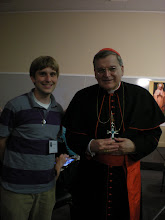And here's cycle four's summary. I changed my method and am happy to tell you that even though my summary for cycle 3 earned me a B+, this one earned an A-. Enjoy
John Paul II begins the fourth cycle of audiences by introducing Ephesians 5:21-33 as a frame for understanding the theology of the body. The cycle can be divided subsequently into three sections.
First, he analyzes in depth Eph 5:21-33 by providing the literary context of the letter. From this, John Paul II teaches that spousal love is reciprocal and communitarian love, analogous to Christ and the Church. This analogy is bi-directional. In other words, not only does marriage of husband and wife give insight into the great mystery of Christ and the Church, but also the reverse is true. John Paul II proposes “redeeming love transforms itself [...] into spousal love” (TOB 90:6). He further explains the supplemental analogy of head and body as it indicates bi-subjectivity (one-flesh unity) for the purpose of sanctification using baptismal and eschatological imagery. His development continues, “This is the moral unity conditioned and constituted by love. Love not only unites two subjects, but allows them to interpenetrate each other, belonging spiritually to one another” (TOB 92:7), eventually culminating in the Eucharist. John Paul II thus draws the connections between the sacramentality of marriage and that of the Church.
Second, John Paul II builds upon the tradition of the Old Testament to connect sacrament and mystery. He affirms that at the center of mystery is Christ. Looking to Isaiah, in relation to Ephesians, John Paul II highlights the Son as the husband-Redeemer of the Church: “the gift of self for the Church is equivalent to the fulfillment of the work of redemption.” (TOB 95:6). He develops further the notion of sacrament as the “visibility of the Invisible”, applying it to both marriage and Christ with the Church. John Paul II then recalls the discussion of marriage as the primordial sacrament, from first cycle, as “it expresses the Creator’s salvific initiative” (TOB 96.7) According to John Paul II, “On the basis of Christ’s spousal love for the Church, the sacrament of redemption—fruit of Christ’s redeeming love—becomes a permanent dimension of the life of the Church herself, a fundamental and life-giving dimension” (TOB 97.4) Thus all sacraments (more inclusive than simply the seven Sacraments proper) of the New Covenant find their prototype in marriage as the primordial sacrament. Also, the Church herself is the “great sacrament”.
Third, John Paul II connects the concept of sacrament with redemption of the body. He returns to the reflections Mt 19 and the indissolubility of marriage in order to link it to Eph 5. Bringing those reflections to light anew, John Paul II teaches that the primordial sacrament, marriage, the sacrament of redemption, is given as grace, yet carries an ethical character: “marriage is also an exhortation to gain mastery over concupiscence” (TOB 101.1). The last point John Paul II makes before concluding the cycle is that, “Through marriage as a sacrament, both of these dimensions of love, the spousal and the redemptive, penetrate together with the grace of the sacrament into the life of the spouses.” (TOB 102.4)




No comments:
Post a Comment